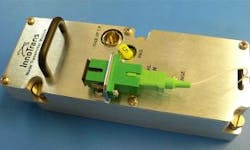As one Diamonds judge aptly put it, the InnoTrans Adaptive Return Transmitter (ART) "addresses an imminent need in (the) HFC network - the ability to operate and bond together multiple upstream DOCSIS carriers at 64-QAM."
The demand for an increase in return bandwidth is placing a strain on node return transmitters. Currently, analog return transmitters operate over a narrow RF input level for a fixed amount of return bandwidth, 5-42 MHz. They are prone to laser clipping, packet loss and degradation in BER performance.The ART uses InnoTrans' Clipping Mitigation Technology and offers 40 dB NPR over a wide dynamic RF input range with performance headroom to handle 200 MHz of 256-QAM signals. InnoTrans says while the latest analog return path lasers might have a pass bandwidth of 200 MHz, most cannot handle full load at the same performance levels as the ART, particularly at modulation levels of 256-QAM.Digital return path solutions, InnoTrans says, require installation of a new headend receiver to self-calibrate to link conditions. ART does not. Since it is linear, it can operate with any recent vintage headend optical receiver product. It also can be loaded with reported 256-QAM upstream carriers and provide the proper link performance. One Diamonds judge noted that digital return systems cannot scale to similar levels and remain cost competitive and called the ART the "right product at the right time," which "should find a welcome home in HFC nodes across North America."www.inno-trans.comSee them at Cable-Tec EXPO, Booth 337Return to the BTR Diamond Technology Reviews Elite.







